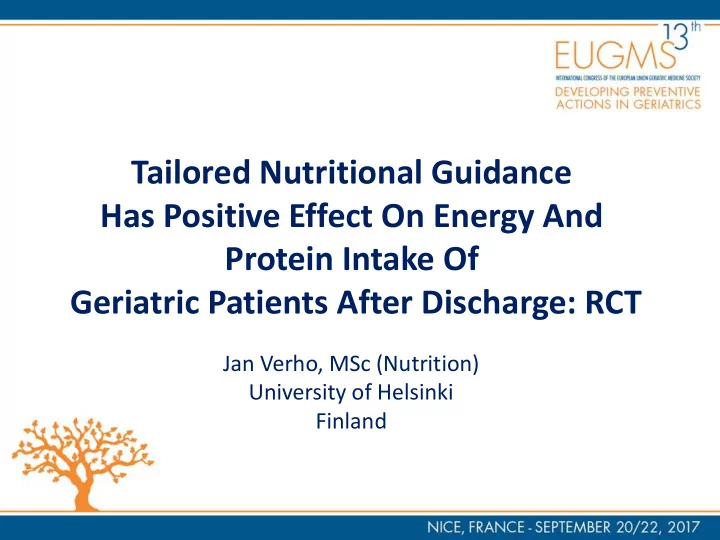

Tailored Nutritional Guidance Has Positive Effect On Energy And Protein Intake Of Geriatric Patients After Discharge: RCT Jan Verho, MSc (Nutrition) University of Helsinki Finland
CONFLICT OF INTEREST DISCLOSURE I have no potential conflict of interest to report
Introduction • Malnutrition is common among hospitalized older adults • Nutritional status may deteriorate during hospital stay • Recovering from acute disease requires good nutritional status and adequate energy and protein intake • Home visits with registered dietitians may have a positive effect on the nutritional status of geriatric medical patients after discharge
Aim of the study • Assess nutritional status, protein and nutrient intake • Investigate the effectiveness of tailored nutritional care with randomized controlled design
Methods • 24-week randomized controlled trial • Independently living older adults discharged from hospital • Normal cognition • MNA was used to assess nutritional status • three-day food diaries collected after discharge and after intervention to assess nutrient intake • Tailored nutritional guidance included – at least one home visit with registered dietitian – personalized nutritional care plan – written material – ONSs when needed
Baseline • 41 (73 % women) participants • Mean age was 76 years • According MNA 61 % were at risk for malnutrition
Percent of all participant reaching adequate intake at baseline Iron 37 Calcium 59 Folate 5 Vitamin C 54 Fibre 10 Protein 17 % 0 10 20 30 40 50 60 70 80 90 100
Protein intake Controls Intervention 80 60 Change in Protein intake, g / day 40 20 p=0.013 0 -20 -40 -60 -80 0 20 40 60 80 100 120 140 0 20 40 60 80 100 120 140 Baseline Protein intake, g / day Baseline Protein intake, g / day
Energy intake Controls Intervention 1600 1400 1200 Change in Energy, kcal / day 1000 800 600 400 200 p=0.025 0 -200 -400 -600 -800 0 500 1000 1500 2000 2500 0 500 1000 1500 2000 2500 Baseline Energy, kcal / day Baseline Energy, kcal / day
Nutrient intake Baseline Change P* Control Intervention Control Intervention Mean (SD) Mean (SD) Mean (95% CI) Mean (95% CI) Iron (mg) 7.55 (2.97) 8.04 (3.50) 1.07 (-0.65 to 2.93) 14.9 (0.6 to 51.30) 0.28 Calcium (mg) 750 (440) 847 (363) 41.4 (-148.62 to 261.70) 205.6 (-6.00 to 390.31) 0.017 Vitamin C (mg) 197 (485) 101 (95) -86.3 (-380.11 to 35.13) 52.2 (15.53 to 102.06) 0.089 Folate (µg) 271 (327) 183 (112) -66.6 (-254.45 to 29.45) 67.7 (12.67 to 114.81) 0.015 Fiber (g) 14.9 (7.3) 17.3 (8.2) 2.95 (1.07 to 5.14) 2.8 (-0.938 to 6.49) 0.80 Sucrose (g) 27.2 (15.0) 33.5 (19.3) -0.1 (-8.05 to 7.49) 1.5 (-8.46 to 15.32) 0.54 PUFA (g) 9.08 (4.39) 7.57 (3.19) -0.1 (-1.88 to 1.43) 3.3 (1.50 to 5.61) 0.012 MUFA (g) 20.1 (9.3) 14.5 (5.6) -0.4 (-4.51 to 3.35) 6.7 (1.60 to 14.55) 0.17 SAFA (g) 18.9 (9.8) 14.1 (6.1) 0.6 (-2.83 to 4.13) 5.9 (1.36 to 10.50) 0.21 * Bootstrap type ANCOVA, baseline as covariate. 0.042 (permutation test)
Conclusions • The risk of malnutrition, poor energy and protein intake are common among geriatric patients after discharge • Tailored nutritional guidance and use of ONSs improve energy and protein intake
Thank you!
Recommend
More recommend